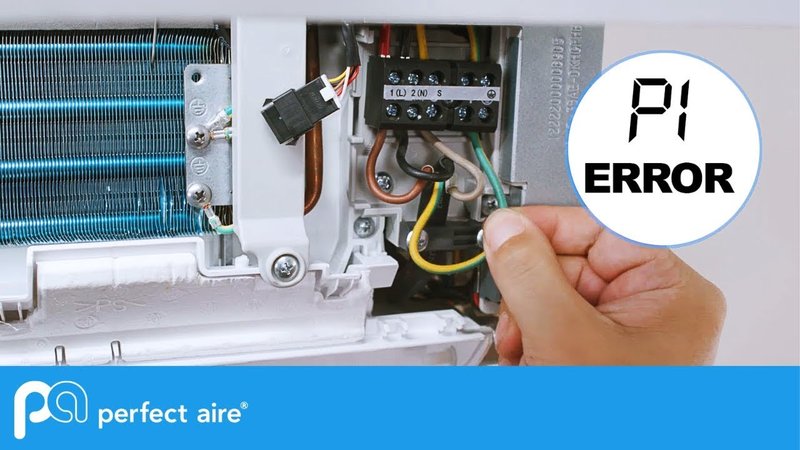
Let’s break this down. The “OE” error code on a Frigidaire air conditioner typically indicates a *drainage problem*. Just like how a kitchen sink can get clogged and cause water to back up, your air conditioner might be facing a similar issue with water not being expelled properly. This usually happens when the drain line is blocked or the pump isn’t functioning as it should. The result? Water builds up, and the system alerts you with that pesky “OE” code. But don’t worry—this doesn’t mean your air conditioner is on its last leg. It just means you might need to do a bit of troubleshooting.
Understanding the OE Error Code on Frigidaire Air Conditioners
Now, let’s dive into what the OE error code really means for your Frigidaire air conditioner. When you see “OE,” it signifies that the unit is struggling to dispose of the condensation it collects while cooling your space. Air conditioners draw moisture from the air to decrease humidity, which then needs to be drained away. Think of it like wringing out a sponge—if you can’t get rid of the water, the sponge gets saturated and stops doing its job.
In an air conditioner, the drained water usually gets channeled away through a drainpipe or pumped out of the system. When there’s a blockage or failure in that process—much like when your sink gets plugged—the water just can’t escape. The error code is your unit’s way of waving a little flag, alerting you to this drainage dilemma.
Using the air conditioner with this error might not be immediately dangerous, but it’s not ideal either. If left unresolved, water build-up can lead to more significant issues, like water leakage or even damage to electrical components. Just like ignoring a leaky roof can lead to bigger problems down the line, turning a blind eye to this error can potentially mean more headaches in the future.
Common Causes of the OE Error Code
So, you’re probably wondering, “Why is this happening?” The main culprits behind the OE error code are usually simple and quite common. First, you could have a *clogged drain line*. Over time, dust, dirt, or mold can accumulate and create a blockage, preventing water from flowing out as it should. Imagine trying to drink from a straw with something stuck inside—it just doesn’t work right, does it?
Another likely cause is a *faulty drain pump*. This pump is responsible for moving the water out, and if it’s not working, the water has nowhere to go. It’s similar to having a weak or broken pump in a fountain—the water can’t circulate, leading to overflow.
Finally, consider the air conditioner’s internal *leveling*. If your unit isn’t sitting level, it can cause water to pool in areas that aren’t designed for water retention. It’s akin to how a tilted pan causes liquid to collect at one end. If your air conditioner isn’t properly balanced, it might struggle to drain effectively.
To deal with these issues, you might need to clean out the drain line, check the functionality of the pump, or ensure the unit is properly leveled. Don’t worry, these are tasks you can either tackle on your own with a bit of guidance or get help from a professional if needed.
Steps to Resolve the OE Error Code
Let’s talk solutions. When confronted with the OE error code, the first step is to *inspect the drain line*. Check for any obvious blockages and see if you can clear them. You can attempt a gentle unclogging using a wire or a specialized cleaner. Think of it as swishing water through a straw to wash out a small particle stuck inside.
Next, observe your unit’s *drain pump*. If it’s not humming along or showing signs of life, it might be defective and in need of replacement. This might be a bit more technical, so if you’re not comfortable, it’s not a bad idea to call in a professional. Just like you’d have a plumber fix a stubborn sink problem, an HVAC technician has the tools and skills to set things right with your air conditioner.
Finally, examine the *leveling of your unit*. Ensure it’s sitting on a flat surface. Sometimes just adjusting its position can resolve drainage issues. It’s a simple fix, like adjusting the legs of a wobbly table to keep everything steady.
Your next steps should include regular maintenance to prevent this from happening again. Clean the air filter and drain line periodically, and ensure there are no obstructions around the unit. Doing so will help keep your air conditioner in top shape and avoid those pesky error codes.
Ultimately, dealing with the OE error code on your Frigidaire air conditioner is manageable and can usually be resolved without too much hassle. Understanding that it’s mainly a drainage issue gives you a solid starting point for troubleshooting. Remember, it’s all about clearing blockages, ensuring the pump is working, and balancing the unit.
It’s safe to use the air conditioner while addressing the OE error, but don’t delay repairs indefinitely—doing so might lead to bigger issues. Consider this code as a friendly reminder that your air conditioner needs a bit of attention, much like a car’s check engine light prompts you to pop the hood and take a look.
For peace of mind and optimal functioning, regular maintenance is key. Check-ups and cleanings could keep your unit running smoothly without error codes flashing at inconvenient times. By staying proactive, you’ll ensure a reliably cool and comfortable environment for you and your loved ones.